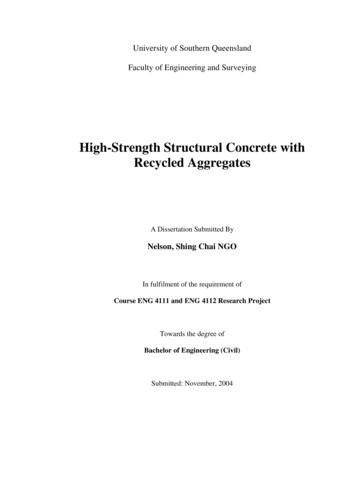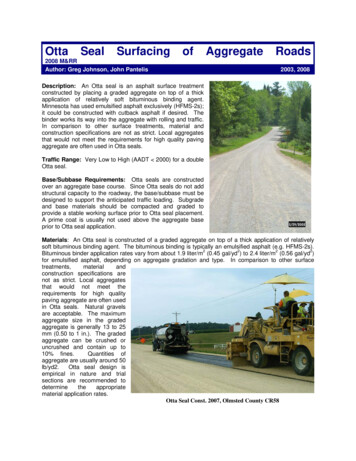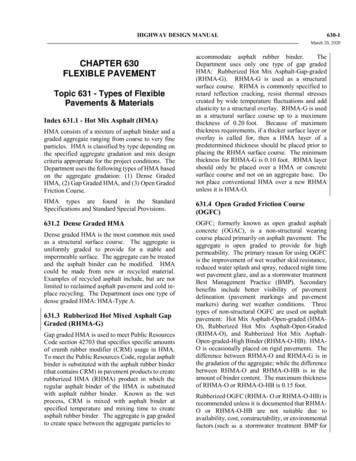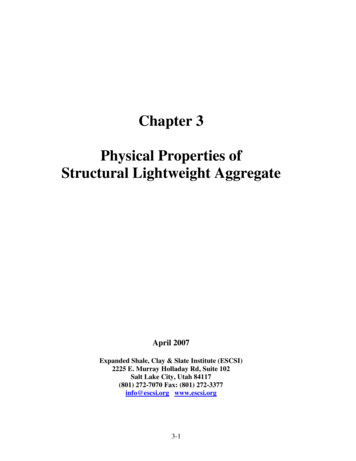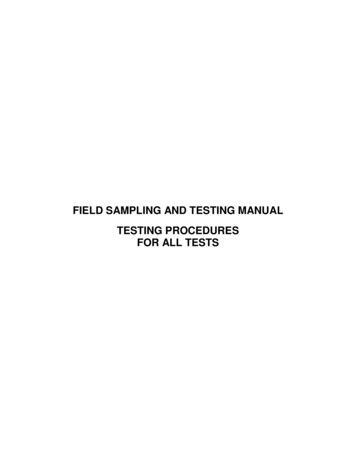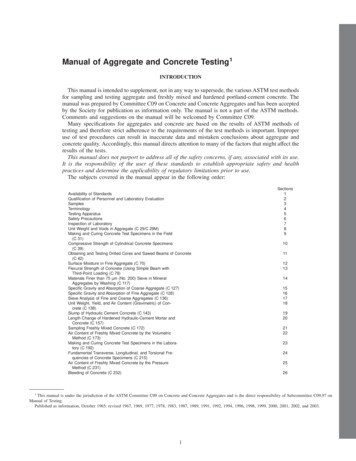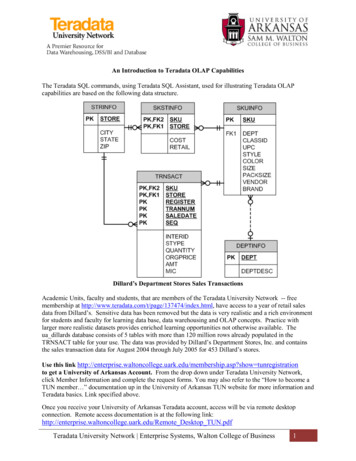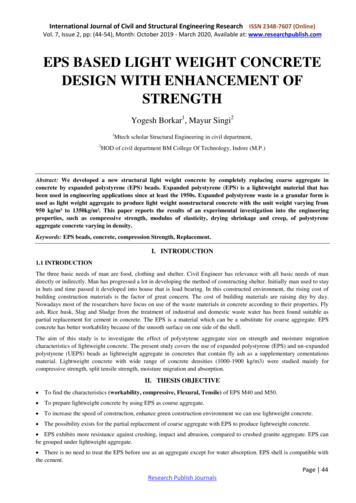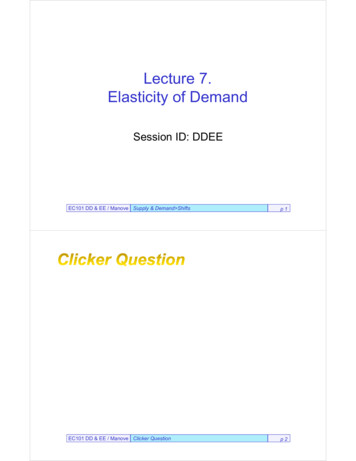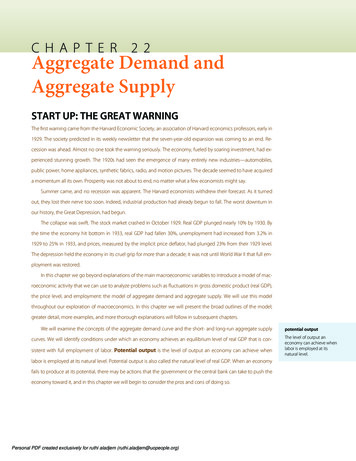
Transcription
CHAP TER22Aggregate Demand andAggregate SupplySTART UP: THE GREAT WARNINGThe first warning came from the Harvard Economic Society, an association of Harvard economics professors, early in1929. The society predicted in its weekly newsletter that the seven-year-old expansion was coming to an end. Recession was ahead. Almost no one took the warning seriously. The economy, fueled by soaring investment, had experienced stunning growth. The 1920s had seen the emergence of many entirely new industries—automobiles,public power, home appliances, synthetic fabrics, radio, and motion pictures. The decade seemed to have acquireda momentum all its own. Prosperity was not about to end, no matter what a few economists might say.Summer came, and no recession was apparent. The Harvard economists withdrew their forecast. As it turnedout, they lost their nerve too soon. Indeed, industrial production had already begun to fall. The worst downturn inour history, the Great Depression, had begun.The collapse was swift. The stock market crashed in October 1929. Real GDP plunged nearly 10% by 1930. Bythe time the economy hit bottom in 1933, real GDP had fallen 30%, unemployment had increased from 3.2% in1929 to 25% in 1933, and prices, measured by the implicit price deflator, had plunged 23% from their 1929 level.The depression held the economy in its cruel grip for more than a decade; it was not until World War II that full employment was restored.In this chapter we go beyond explanations of the main macroeconomic variables to introduce a model of macroeconomic activity that we can use to analyze problems such as fluctuations in gross domestic product (real GDP),the price level, and employment: the model of aggregate demand and aggregate supply. We will use this modelthroughout our exploration of macroeconomics. In this chapter we will present the broad outlines of the model;greater detail, more examples, and more thorough explanations will follow in subsequent chapters.We will examine the concepts of the aggregate demand curve and the short- and long-run aggregate supplycurves. We will identify conditions under which an economy achieves an equilibrium level of real GDP that is consistent with full employment of labor. Potential output is the level of output an economy can achieve whenlabor is employed at its natural level. Potential output is also called the natural level of real GDP. When an economyfails to produce at its potential, there may be actions that the government or the central bank can take to push theeconomy toward it, and in this chapter we will begin to consider the pros and cons of doing so.Personal PDF created exclusively for ruthi aladjem (ruthi.aladjem@uopeople.org)potential outputThe level of output aneconomy can achieve whenlabor is employed at itsnatural level.
546PRINCIPLES OF ECONOMICS1. AGGREGATE DEMANDL E A R N I N GO B J E C T I V E S1. Define potential output, also called the natural level of GDP.2. Define aggregate demand, represent it using a hypothetical aggregate demand curve, andidentify and explain the three effects that cause this curve to slope downward.3. Distinguish between a change in the aggregate quantity of goods and services demanded anda change in aggregate demand.4. Use examples to explain how each component of aggregate demand can be a possible aggregate demand shifter.5. Explain what a multiplier is and tell how to calculate it.aggregate demandThe relationship between thetotal quantity of goods andservices demanded (from allthe four sources of demand)and the price level, all otherdeterminants of spendingunchanged.aggregate demand curveA graphical representation ofaggregate demand.Firms face four sources of demand: households (personal consumption), other firms (investment), government agencies (government purchases), and foreign markets (net exports). Aggregate demand isthe relationship between the total quantity of goods and services demanded (from all the four sourcesof demand) and the price level, all other determinants of spending unchanged. The aggregate demand curve is a graphical representation of aggregate demand.1.1 The Slope of the Aggregate Demand CurveWe will use the implicit price deflator as our measure of the price level; the aggregate quantity of goodsand services demanded is measured as real GDP. The table in Figure 22.1 gives values for each component of aggregate demand at each price level for a hypothetical economy. Various points on the aggregate demand curve are found by adding the values of these components at different price levels. Theaggregate demand curve for the data given in the table is plotted on the graph in Figure 22.1. At pointA, at a price level of 1.18, 11,800 billion worth of goods and services will be demanded; at point C, areduction in the price level to 1.14 increases the quantity of goods and services demanded to 12,000billion; and at point E, at a price level of 1.10, 12,200 billion will be demanded.FIGURE 22.1 Aggregate DemandAn aggregate demand curve (AD) shows the relationship between the total quantity of output demanded(measured as real GDP) and the price level (measured as the implicit price deflator). At each price level, the totalquantity of goods and services demanded is the sum of the components of real GDP, as shown in the table. Thereis a negative relationship between the price level and the total quantity of goods and services demanded, all otherthings unchanged.Personal PDF created exclusively for ruthi aladjem (ruthi.aladjem@uopeople.org)
CHAPTER 22AGGREGATE DEMAND AND AGGREGATE SUPPLYThe negative slope of the aggregate demand curve suggests that it behaves in the same manner as an ordinary demand curve. But we cannot apply the reasoning we use to explain downward-sloping demandcurves in individual markets to explain the downward-sloping aggregate demand curve. There are tworeasons for a negative relationship between price and quantity demanded in individual markets. First, alower price induces people to substitute more of the good whose price has fallen for other goods, increasing the quantity demanded. Second, the lower price creates a higher real income. This normallyincreases quantity demanded further.Neither of these effects is relevant to a change in prices in the aggregate. When we are dealing withthe average of all prices—the price level—we can no longer say that a fall in prices will induce a changein relative prices that will lead consumers to buy more of the goods and services whose prices havefallen and less of the goods and services whose prices have not fallen. The price of corn may have fallen,but the prices of wheat, sugar, tractors, steel, and most other goods or services produced in the economy are likely to have fallen as well.Furthermore, a reduction in the price level means that it is not just the prices consumers pay thatare falling. It means the prices people receive—their wages, the rents they may charge as landlords, theinterest rates they earn—are likely to be falling as well. A falling price level means that goods and services are cheaper, but incomes are lower, too. There is no reason to expect that a change in real incomewill boost the quantity of goods and services demanded—indeed, no change in real income would occur. If nominal incomes and prices all fall by 10%, for example, real incomes do not change.Why, then, does the aggregate demand curve slope downward? One reason for the downwardslope of the aggregate demand curve lies in the relationship between real wealth (the stocks, bonds, andother assets that people have accumulated) and consumption (one of the four components of aggregatedemand). When the price level falls, the real value of wealth increases—it packs more purchasingpower. For example, if the price level falls by 25%, then 10,000 of wealth could purchase more goodsand services than it would have if the price level had not fallen. An increase in wealth will inducepeople to increase their consumption. The consumption component of aggregate demand will thus begreater at lower price levels than at higher price levels. The tendency for a change in the price level toaffect real wealth and thus alter consumption is called the wealth effect; it suggests a negative relationship between the price level and the real value of consumption spending.A second reason the aggregate demand curve slopes downward lies in the relationship between interest rates and investment. A lower price level lowers the demand for money, because less money is required to buy a given quantity of goods. What economists mean by money demand will be explained inmore detail in a later chapter. But, as we learned in studying demand and supply, a reduction in the demand for something, all other things unchanged, lowers its price. In this case, the “something” ismoney and its price is the interest rate. A lower price level thus reduces interest rates. Lower interestrates make borrowing by firms to build factories or buy equipment and other capital more attractive. Alower interest rate means lower mortgage payments, which tends to increase investment in residentialhouses. Investment thus rises when the price level falls. The tendency for a change in the price level toaffect the interest rate and thus to affect the quantity of investment demanded is called the interestrate effect. John Maynard Keynes, a British economist whose analysis of the Great Depression andwhat to do about it led to the birth of modern macroeconomics, emphasized this effect. For this reason,the interest rate effect is sometimes called the Keynes effect.A third reason for the rise in the total quantity of goods and services demanded as the price levelfalls can be found in changes in the net export component of aggregate demand. All other things unchanged, a lower price level in an economy reduces the prices of its goods and services relative toforeign-produced goods and services. A lower price level makes that economy’s goods more attractiveto foreign buyers, increasing exports. It will also make foreign-produced goods and services less attractive to the economy’s buyers, reducing imports. The result is an increase in net exports. The international trade effect is the tendency for a change in the price level to affect net exports.Taken together, then, a fall in the price level means that the quantities of consumption, investment, and net export components of aggregate demand may all rise. Since government purchases aredetermined through a political process, we assume there is no causal link between the price level andthe real volume of government purchases. Therefore, this component of GDP does not contribute tothe downward slope of the curve.In general, a change in the price level, with all other determinants of aggregate demand unchanged, causes a movement along the aggregate demand curve. A movement along an aggregate demand curve is a change in the aggregate quantity of goods and services demanded. A movement from point A to point B on the aggregate demand curve in Figure 22.1 is an example. Such achange is a response to a change in the price level.Notice that the axes of the aggregate demand curve graph are drawn with a break near the origin toremind us that the plotted values reflect a relatively narrow range of changes in real GDP and the pricelevel. We do not know what might happen if the price level or output for an entire economy approached zero. Such a phenomenon has never been observed.Personal PDF created exclusively for ruthi aladjem (ruthi.aladjem@uopeople.org)547wealth effectThe tendency for a change inthe price level to affect realwealth and thus alterconsumption.interest rate effectThe tendency for a change inthe price level to affect theinterest rate and thus toaffect the quantity ofinvestment demanded.international trade effectThe tendency for a change inthe price level to affect netexports.change in the aggregatequantity of goods andservices demandedMovement along anaggregate demand curve.
548PRINCIPLES OF ECONOMICS1.2 Changes in Aggregate Demandchange in aggregatedemandChange in the aggregatequantity of goods andservices demanded at everyprice level.Aggregate demand changes in response to a change in any of its components. An increase in the totalquantity of consumer goods and services demanded at every price level, for example, would shift theaggregate demand curve to the right. A change in the aggregate quantity of goods and services demanded at every price level is a change in aggregate demand, which shifts the aggregate demand curve.Increases and decreases in aggregate demand are shown in Figure 22.2.FIGURE 22.2 Changes in Aggregate DemandAn increase in consumption, investment, government purchases, or net exports shifts the aggregate demand curveAD1 to the right as shown in Panel (a). A reduction in one of the components of aggregate demand shifts the curveto the left, as shown in Panel (b).What factors might cause the aggregate demand curve to shift? Each of the components of aggregatedemand is a possible aggregate demand shifter. We shall look at some of the events that can triggerchanges in the components of aggregate demand and thus shift the aggregate demand curve.Changes in ConsumptionSeveral events could change the quantity of consumption at each price level and thus shift aggregatedemand. One determinant of consumption is consumer confidence. If consumers expect good economic conditions and are optimistic about their economic prospects, they are more likely to buy majoritems such as cars or furniture. The result would be an increase in the real value of consumption ateach price level and an increase in aggregate demand. In the second half of the 1990s, sustained economic growth and low unemployment fueled high expectations and consumer optimism. Surveys revealed consumer confidence to be very high. That consumer confidence translated into increased consumption and increased aggregate demand. In contrast, a decrease in consumption would accompanydiminished consumer expectations and a decrease in consumer confidence, as happened after the stockmarket crash of 1929. The same problem has plagued the economies of most Western nations in 2008as declining consumer confidence has tended to reduce consumption. A survey by the ConferenceBoard in September of 2008 showed that just 13.5% of consumers surveyed expected economic conditions in the United States to improve in the next six months. Similarly pessimistic views prevailed inthe previous two months. That contributed to the decline in consumption that occurred in the thirdquarter of the year.Another factor that can change consumption and shift aggregate demand is tax policy. A cut inpersonal income taxes leaves people with more after-tax income, which may induce them to increasetheir consumption. The federal government in the United States cut taxes in 1964, 1981, 1986, 1997,and 2003; each of those tax cuts tended to increase consumption and aggregate demand at each pricelevel.In the United States, another government policy aimed at increasing consumption and thus aggregate demand has been the use of rebates in which taxpayers are simply sent checks in hopes thatPersonal PDF created exclusively for ruthi aladjem (ruthi.aladjem@uopeople.org)
CHAPTER 22AGGREGATE DEMAND AND AGGREGATE SUPPLY549those checks will be used for consumption. Rebates have been used in 1975, 2001, and 2008. In eachcase the rebate was a one-time payment. Careful studies by economists of the 1975 and 2001 rebatesshowed little impact on consumption. Final evidence on the impact of the 2008 rebates is not yet in, butearly results suggest a similar outcome. In a subsequent chapter, we will investigate arguments aboutwhether temporary increases in income produced by rebates are likely to have a significant impact onconsumption.Transfer payments such as welfare and Social Security also affect the income people have availableto spend. At any given price level, an increase in transfer payments raises consumption and aggregatedemand, and a reduction lowers consumption and aggregate demand.Changes in InvestmentInvestment is the production of new capital that will be used for future production of goods and services. Firms make investment choices based on what they think they will be producing in the future.The expectations of firms thus play a critical role in determining investment. If firms expect their salesto go up, they are likely to increase their investment so that they can increase production and meetconsumer demand. Such an increase in investment raises the aggregate quantity of goods and servicesdemanded at each price level; it increases aggregate demand.Changes in interest rates also affect investment and thus affect aggregate demand. We must becareful to distinguish such changes from the interest rate effect, which causes a movement along the aggregate demand curve. A change in interest rates that results from a change in the price level affects investment in a way that is already captured in the downward slope of the aggregate demand curve; itcauses a movement along the curve. A change in interest rates for some other reason shifts the curve.We examine reasons interest rates might change in another chapter.Investment can also be affected by tax policy. One provision of the Job and Growth Tax Relief Reconciliation Act of 2003 was a reduction in the tax rate on certain capital gains. Capital gains resultwhen the owner of an asset, such as a house or a factory, sells the asset for more than its purchase price(less any depreciation claimed in earlier years). The lower capital gains tax could stimulate investment,because the owners of such assets know that they will lose less to taxes when they sell those assets, thusmaking assets subject to the tax more attractive.Changes in Government PurchasesAny change in government purchases, all other things unchanged, will affect aggregate demand. An increase in government purchases increases aggregate demand; a decrease in government purchases decreases aggregate demand.Many economists argued that reductions in defense spending in the wake of the collapse of theSoviet Union in 1991 tended to reduce aggregate demand. Similarly, increased defense spending for thewars in Afghanistan and Iraq increased aggregate demand. Dramatic increases in defense spending tofight World War II accounted in large part for the rapid recovery from the Great Depression.Changes in Net ExportsA change in the value of net exports at each price level shifts the aggregate demand curve. A major determinant of net exports is foreign demand for a country’s goods and services; that demand will varywith foreign incomes. An increase in foreign incomes increases a country’s net exports and aggregatedemand; a slump in foreign incomes reduces net exports and aggregate demand. For example, severalmajor U.S. trading partners in Asia suffered recessions in 1997 and 1998. Lower real incomes in thosecountries reduced U.S. exports and tended to reduce aggregate demand.Exchange rates also influence net exports, all other things unchanged. A country’s exchange rateis the price of its currency in terms of another currency or currencies. A rise in the U.S. exchange ratemeans that it takes more Japanese yen, for example, to purchase one dollar. That also means that U.S.traders get more yen per dollar. Since prices of goods produced in Japan are given in yen and prices ofgoods produced in the United States are given in dollars, a rise in the U.S. exchange rate increases theprice to foreigners for goods and services produced in the United States, thus reducing U.S. exports; itreduces the price of foreign-produced goods and services for U.S. consumers, thus increasing importsto the United States. A higher exchange rate tends to reduce net exports, reducing aggregate demand. Alower exchange rate tends to increase net exports, increasing aggregate demand.Foreign price levels can affect aggregate demand in the same way as exchange rates. For example,when foreign price levels fall relative to the price level in the United States, U.S. goods and services become relatively more expensive, reducing exports and boosting imports in the United States. Such a reduction in net exports reduces aggregate demand. An increase in foreign prices relative to U.S. priceshas the opposite effect.The trade policies of various countries can also affect net exports. A policy by Japan to increase itsimports of goods and services from India, for example, would increase net exports in India.Personal PDF created exclusively for ruthi aladjem (ruthi.aladjem@uopeople.org)exchange rateThe price of a currency interms of another currency orcurrencies.
550PRINCIPLES OF ECONOMICSThe MultipliermultiplierThe ratio of the change in thequantity of real GDPdemanded at each price levelto the initial change in one ormore components ofaggregate demand thatproduced it.A change in any component of aggregate demand shifts the aggregate demand curve. Generally, the aggregate demand curve shifts by more than the amount by which the component initially causing it toshift changes.Suppose that net exports increase due to an increase in foreign incomes. As foreign demand fordomestically made products rises, a country’s firms will hire additional workers or perhaps increase theaverage number of hours that their employees work. In either case, incomes will rise, and higher incomes will lead to an increase in consumption. Taking into account these other increases in the components of aggregate demand, the aggregate demand curve will shift by more than the initial shiftcaused by the initial increase in net exports.The multiplier is the ratio of the change in the quantity of real GDP demanded at each price levelto the initial change in one or more components of aggregate demand that produced it:EQUATION 22.1Multiplier Δ (real GDP demanded at each price level)initial Δ (component of AD)We use the capital Greek letter delta (Δ) to mean “change in.” In the aggregate demand–aggregatesupply model presented in this chapter, it is the number by which we multiply an initial change in aggregate demand to obtain the amount by which the aggregate demand curve shifts as a result of the initial change. In other words, we can use Equation 22.1 to solve for the change in real GDP demanded ateach price level:EQUATION 22.2Δ (real GDP demanded at each price level) multiplier initial Δ (component of AD)Suppose that the initial increase in net exports is 100 billion and that the initial 100-billion increase generates additional consumption of 100 billion at each price level. In Panel (a) of Figure 22.3,the aggregate demand curve shifts to the right by 200 billion—the amount of the initial increase in netexports times the multiplier of 2. We obtained the value for the multiplier in this example by plugging 200 billion (the initial 100-billion increase in net exports plus the 100-billion increase that it generated in consumption) into the numerator of Equation 22.1 and 100 billion into the denominator. Similarly, a decrease in net exports of 100 billion leads to a decrease in aggregate demand of 200 billionat each price level, as shown in Panel (b).FIGURE 22.3 The MultiplierA change in one component of aggregate demand shifts the aggregate demand curve by more than the initialchange. In Panel (a), an initial increase of 100 billion of net exports shifts the aggregate demand curve to the rightby 200 billion at each price level. In Panel (b), a decrease of net exports of 100 billion shifts the aggregatedemand curve to the left by 200 billion. In this example, the multiplier is 2.Personal PDF created exclusively for ruthi aladjem (ruthi.aladjem@uopeople.org)
CHAPTER 22AGGREGATE DEMAND AND AGGREGATE SUPPLYK E Y T A K E A W A Y SPotential output is the level of output an economy can achieve when labor is employed at its natural level.When an economy fails to produce at its potential, the government or the central bank may try to pushthe economy toward its potential.The aggregate demand curve represents the total of consumption, investment, government purchases,and net exports at each price level in any period. It slopes downward because of the wealth effect onconsumption, the interest rate effect on investment, and the international trade effect on net exports.The aggregate demand curve shifts when the quantity of real GDP demanded at each price level changes.The multiplier is the number by which we multiply an initial change in aggregate demand to obtain theamount by which the aggregate demand curve shifts at each price level as a result of the initial change.T R YI T !Explain the effect of each of the following on the aggregate demand curve for the United States:1.2.3.4.A decrease in consumer optimismAn increase in real GDP in the countries that buy U.S. exportsAn increase in the price levelAn increase in government spending on highwaysCase in Point: The Multiplied Economic Impact of SARS on China’s EconomySevere Acute Respiratory Syndrome (SARS), an atypical pneumonia-like disease, broke onto the world scene inlate 2002. In March 2003, the World Health Organization (WHO) issued its first worldwide alert and a monthlater its first travel advisory, which recommended that travelers avoid Hong Kong and the southern provinceof China, Guangdong. Over the next few months, additional travel advisories were issued for other parts of China, Taiwan, and briefly for Toronto, Canada. By the end of June, all WHO travel advisories had been removed.To estimate the overall impact of SARS on the Chinese economy in 2003, economists Wen Hai, Zhong Zhao,and Jian Want of Peking University’s China Center for Economic Research conducted a survey of Beijing’s tourism industry in April 2003. Based on findings from the Beijing area, they projected the tourism sector of Chinaas a whole would lose 16.8 billion—of which 10.8 billion came from an approximate 50% reduction in foreign tourist revenue and 6 billion from curtailed domestic tourism, as holiday celebrations were cancelledand domestic travel restrictions imposed.To figure out the total impact of SARS on China’s economy, they argued that the multiplier for tourism revenue in China is between 2 and 3. Since the SARS outbreak only began to have a major economic impact afterMarch, they assumed a smaller multiplier of 1.5 for all of 2003. They thus predicted that the Chinese economywould be 25.3 billion smaller in 2003 as a result of SARS:Source: Wen Hai, Zhong Zhao, and Jian Wan, “The Short-Term Impact of SARS on the Chinese Economy,” Asian Economic Papers 3, no. 1 (Winter2004): 57–61.Personal PDF created exclusively for ruthi aladjem (ruthi.aladjem@uopeople.org)551
552PRINCIPLES OF ECONOMICSA N S W E RT OT R YI T !P R O B L E M1. A decline in consumer optimism would cause the aggregate demand curve to shift to the left. Ifconsumers are more pessimistic about the future, they are likely to cut purchases, especially of majoritems.2. An increase in the real GDP of other countries would increase the demand for U.S. exports and cause theaggregate demand curve to shift to the right. Higher incomes in other countries will make consumers inthose countries more willing and able to buy U.S. goods.3. An increase in the price level corresponds to a movement up along the unchanged aggregate demandcurve. At the higher price level, the consumption, investment, and net export components of aggregatedemand will all fall; that is, there will be a reduction in the total quantity of goods and services demanded,but not a shift of the aggregate demand curve itself.4. An increase in government spending on highways means an increase in government purchases. Theaggregate demand curve would shift to the right.2. AGGREGATE DEMAND AND AGGREGATE SUPPLY:THE LONG RUN AND THE SHORT RUNL E A R N I N GO B J E C T I V E S1. Distinguish between the short run and the long run, as these terms are used inmacroeconomics.2. Draw a hypothetical long-run aggregate supply curve and explain what it shows about the natural levels of employment and output at various price levels, given changes in aggregatedemand.3. Draw a hypothetical short-run aggregate supply curve, explain why it slopes upward, and explain why it may shift; that is, distinguish between a change in the aggregate quantity of goodsand services supplied and a change in short-run aggregate supply.4. Discuss various explanations for wage and price stickiness.5. Explain and illustrate what is meant by equilibrium in the short run and relate the equilibriumto potential output.long runIn macroeconomics, we seek to understand two types of equilibria, one corresponding to the short runand the other corresponding to the long run. The short run in macroeconomic analysis is a period inwhich wages and some other prices do not respond to changes in economic conditions. In certain markets, as economic conditions change, prices (including wages) may not adjust quickly enough to maintain equilibrium in these markets. A sticky price is a price that is slow to adjust to its equilibriumlevel, creating sustained periods of shortage or surplus. Wage and price stickiness prevent the economyfrom achieving its natural level of employment and its potential output. In contrast, the long run inmacroeconomic analysis is a period in which wages and prices are flexible. In the long run, employment will move to its natural level and real GDP to potential.We begin with a discussion of long-run macroeconomic equilibrium, because this type of equilibrium allows us to see the macroeconomy after full market adjustment has been achieved. In contrast, inthe short run, price or wage stickiness is an obstacle to full adjustment. Why these deviations from thepotential level of output occur and what the implications are for the macroeconomy will be discussedin the section on short-run macroeconomic equilibrium.In macroeconomic analysis, aperiod in which wages andprices are flexible.2.1 The Long Runshort
550 PRINCIPLES OF ECONOMICS Personal PDF created exclusively for ruthi aladjem (ruthi.aladjem@uopeople.org) KEY TAKEAWAYS Potential output is the level of output an economy can achieve when labor is employed at its natural level. When an economy fails to produce at its potentia

